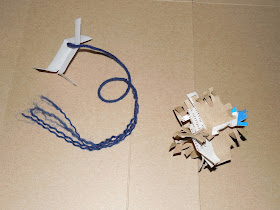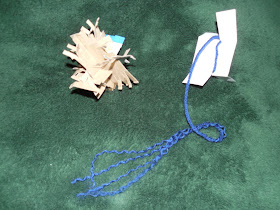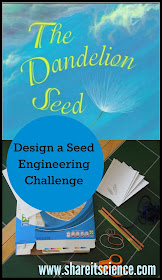Floating, flying, hitchhiking...plant seeds have many adaptations for survival. Challenge your kids or students to design their own seeds. What adaptations for survival do your seeds have?
This is a great opportunity to learn the engineering process. Explore plant adaptations and life cycles. Observe the variety found in real plant seeds. So many possibilities here for science and engineering!
This post contains affiliate links, meaning that I receive a small commission for purchases made after clicking these links, at no additional cost to you. Please see disclosures for more information.
Amazing Plant Seeds
I love seeds! All the different shapes,
the variety, the adaptations for survival, they are all pretty
amazing. When learning about seeds with kids, one of my favorite
picture books to read is the beautifully illustrated story, The Dandelion Seed, by Joseph Anthony and illustrated by Cris Arbo.
The story follows a hesitant dandelion
seed as it floats away from its plant in the fall. Throughout its
adventure it passes through the 4 seasons, by cities and countryside
until eventually it comes full circle and grows into a dandelion
plant. This plant makes seeds as well that head off on their own
adventures on the last page.
The book is a great entry point to
many science topics including plant life cycles, seasonal changes and
plant adaptations. The topic of plant adaptations leads us to a fun
engineering challenge: design a seed! Some seeds fly in the air, some
float in the water. Some stick to the fur of animals, our socks and
pants to get from one place to another. Some even must be digested
before they can grow!
Seed Engineering Design Challenge
You can use any household materials for
your design challenge. I suggest items such as: scrap paper, box
board (cereal boxes, cracker boxes etc.) drinking straws, string, 3x5
index cards, rubberbands, paperclips and scissors. To make it more of
a challenge do not include tape, glue or velcro in your supplies.
Although most seeds are fairly small,
your designs can be as big as you'd like, as long as they float, fly
and stick you've accomplished your goal!
Once you've created a seed that you
think will fly, test it out! If it is a dry day you can take your
seed outside, or (keeping safety in mind) drop it out an upstairs
window. You can also set up a fan and test it indoors. (Please watch
out for little fingers!)
How did your seed do? Do you need to
redesign and try again?
You can test your floating seed in the
sink, a basin or the bathtub.
Find a fuzzy blanket, fleece jacket, or
patient pet to test your sticky seed out. How well do they work? It
is okay to tweak your design, that is what professional engineers do!
 |
| Floating seed designs. ©SBF 2016 |
 |
| Testing floating seeds. ©SBF 2016 |
 |
| Sticky seed designs. ©SBF 2016 |
 |
| Testing sticky seeds on a fuzzy blanket. ©SBF 2016 |
Picture Books for Studying Plant Seeds
Once you are finished, you might want
to learn more about seed adaptations. What different shapes do seeds
come in? Can you find any that look like the seeds you created? I
suggest picking up a copy of Flip, Float, Fly: Seeds on the Move by
JoAnn Early Macken, illustrated by Pam Paparone. This colorful story
with fun text describes how many different types of seeds travel,
with an example of each. Who knows, maybe it will inspire a new seed
design challenge?
Another excellent non-fiction picture
book is How and Why? Seeds Travel by Elaine Pascoe with photographs
by Dwight Kuhn. This book has great close-up photography of seeds on
the move and their growth and development. It wraps up with some
additional learning activities to try.
If you enjoyed The Dandelion Seed,
you'll also like the Joseph Anthony's second story about dandelion
seeds, The Dandelion Seed's Big Dream. This one follows a seeds
plight through some tough conditions before its dream comes true, to
grow into a flower. Some science ideas here are persistence in
nature, plant adaptations and life cycles. There is also a nice
section in the back of the book with some scientific information
about dandelion plants.
If you love books and science, then you
definitely will enjoy the Storybook Science series at Inspiration Laboratories!






I love the idea of learning about seeds and engineering your own!
ReplyDeleteThanks, Trisha! The activity is definitely a hit with the kids too!
DeleteI love the seed design challenge - and what a good selection of books.
ReplyDeleteThanks Sue! The Dandelion Seed is one of my favorites!
DeleteSo fun!
ReplyDeleteIt's definitely and engaging activity, and helps kids to notice details about seeds later on too!
DeleteWhat ages do you think is good for?
ReplyDeleteGreat question! I've done this with all levels of elementary. I think it is best for grade 3-5, but even younger kids enjoy building and testing things.
Delete